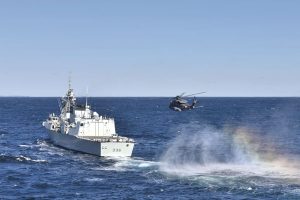X-Ship leads the way to innovation
By Lookout on Apr 05, 2016 with Comments 0

Photo by Cpl Anthony Laviolette
A Cyclone helicopter prepares to land on the flight deck of HMCS Montréal off the coast of Halifax March 3.
Darlene Blakeley, Public Affairs Ottawa ~
For the next five years, HMCS Montréal will have a new role to fill along with its regular naval requirements.
Montréal has been named the Royal Canadian Navy’s Experimental Ship – or “X-Ship” – a program designed to advance innovative and leading-edge naval concepts in all areas of warship deployment, crewing and sustainment.
“To do this, we have been allotted a five-year period within which to build and execute a program that builds on existing trial concepts and develops new ones,” says Lieutenant-Commander Lorraine Sammut, Senior Staff Officer Operations at the New Capability Introduction Detachment in Esquimalt, B.C. “Specifically, X-Ship will be tasked to conduct experiments that fall outside of normal fleet development activities, and be focused on supporting future classes of ships such as the Canadian Surface Combatant and Joint Support Ship.”
In the short term, many of the trials conducted will focus on human factors such as variations of crew size and impacts on crew rest and performance, as well as some operational trials.
“One of the driving tenets behind X-Ship is to explore crew modelling initiatives – future practices – that are forecasted to be employed in our next classes of ship,” explains LCdr Sammut. “One of the challenges we face is forecasting the level of human effort required to conduct a certain task, given that future ships will have increased levels of automation. To forecast the baseline, the navy, in partnership with Defence Research and Development Canada, uses a crew modelling prediction software and inputs what we already know to be true.”
Medium and long term horizons will see an increased focus on operational and technical type trials, including structural health monitoring, environmental effects on the ship and information systems trials.
“In the long term, we anticipate that the conduct of naval operations will be shaped by the data collected from these experiments and trials,” says LCdr Sammut. “As we move towards new ship design, one emerging trend is the shift to increased automation across a variety of systems. By default, increased automation equals decreased crew size and a requirement to employ specialized teams depending on the mission at hand.”
Crewing configuration will vary over the five-year program and is dependent on the crewing experiment being conducted at the time. Notwithstanding, X-Ship will remain crewed by Canadian Armed Forces personnel, and outside of the crew experiments being conducted, Montréal will be crewed as usual for Halifax-class frigates.
In support of future platforms like Canadian Surface Combatant where crew size is forecasted to be smaller than the current frigate model, one crewing concept being tested early in the program is a reduced crew complement.
“The goal behind any crewing model is to arrive at an appropriate and sustainable complement to execute the variety of normal readiness tasks encountered during naval operations,” says LCdr Sammut.
The innovative X-Ship program will benefit the Royal Canadian Navy (RCN) in many ways as streamlining capabilities and finding new efficiencies allows increased effectiveness across a wide array of naval operations.
“In the same vein, it also allows the RCN to determine, with some empirical accuracy, where certain concepts fall short and the diversity of operational effectiveness is potentially compromised, thus requiring further work,” explains LCdr Sammut. “Either way, providing a platform to advance innovative efforts is a tremendous win in the eyes of force developers and our operational community. Likewise, and on the heels of our successful modernization of the Halifax Class, it allows the RCN to align itself with those successful advances made by our allied partners.”
Although X-Ship will have a dedicated trial program, it will not be completely removed from everyday naval requirements and will continue to participate in scheduled engineering repair, docking work periods, fleet training exercises and support to the new shipborne Cyclone helicopter.
“In fact these opportunities lend a considerable hand in providing the appropriate test environment for many of the trials to be conducted,” says LCdr Sammut.
In recognition of the unique nature of the program, Vice-Admiral Mark Norman, Commander of the RCN, has directed that a special badge be designed for X-Ship. Details about the badge and what it will look like are expected to be announced in the coming months.
It’s a busy and exciting time for Montréal crew members and supporting staff ashore as the frigate moves forward with the X-Ship program, leading the RCN in ground-breaking experiments and trials.
Filed Under: Top Stories
About the Author:





